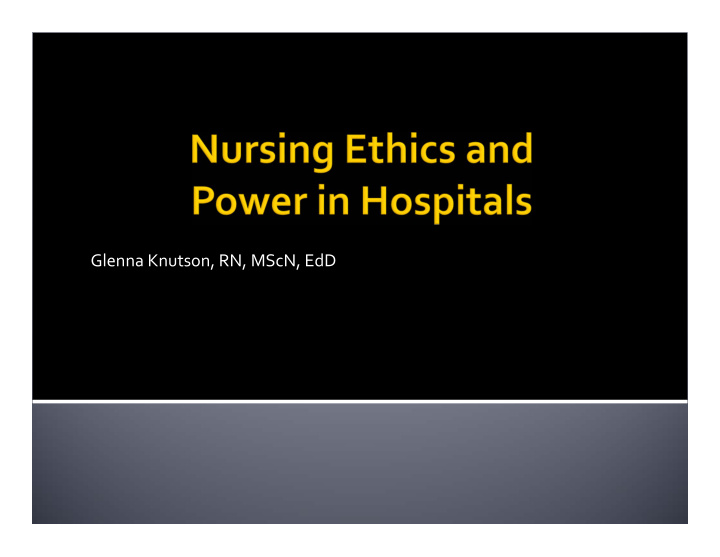



Glenna Knutson, RN, MScN, EdD
Why study hospital nurses’ ethical decision making? Literature: Nurses depicted as disempowered professionals Deteriorating ethical climate for nurses in 1990s and 2000s Power and the origin of organizational decisions Impact of the organization on nurses’ ethical problem solving
Definitions can be positive or negative Positive definition: “the ability (or potential) to exert actions that either directly or indirectly cause change in the behaviour and/or attitudes of another individual or group” (Alexander & Morlock, 2000)
Power differences can be seen as a means to social order, or bringing about inequality between groups Power of position (also called legitimate power) and coercive power (sanction) are currently aspects of hierarchical organizations Power of expertise sometimes unacknowledged in nurses (e.g. St. Boniface baby deaths) Diversity in modern organizations can lead to conflict and power struggles ( Gaudine & Lamb, 2015)
Over time, nurses have tended to view: themselves as relatively powerless in health care organizations leaders (administrators and physicians) as fostering rigidly hierarchical and patriarchal organizational cultures (Sieloff, 2004)
Purpose: explore nurses’ perceptions of how their own qualities and hospital environment contributed to their ethical problem solving Methodology: Interviews with 10 experienced nurses who defined selves as ethically ‐ active, working in two different types of hospitals, Ethical protections Analysis: Data transcribed, coded, analysed using Constant comparison method: themes emerged
1. Nurses’ qualities and ethical problem solving 2. Ethical problems described by participants 3. The two organizational contexts
The nurses in this study depicted selves as being characterized by: Concern for the patient Focus on the patient’s best interest Willingness to advocate Recognition of the complexity of the interpersonal context
The nurses in this study depicted selves as being characterized by: Respect and concern for ▪ families ▪ coworkers ▪ other health care providers
The nurses in this study depicted selves as being characterized by: professional motivations: ▪ professional values ▪ clinical experience ▪ previous experiences with ethical problems
A wide range of ethical problems including issues around end of life, decisional conflict, caregiver competence . . . . . . which could be distilled as decisions of others which violated or threatened the patients’ rights, wishes, best interests, best outcomes
Ethical problem solving emerged as being intensely interpersonal within a complex relational context of ethical problems and solutions Nurses’ ethical action varied from doing nothing to actions that risked their own employment and/or careers
Similarities: Key role of the manager Relational matrix of others on nursing unit: could assist or hinder Coworkers as supports and sources of problems, caution in speaking with coworkers about care lapses
Similarities: Hierarchy, including legal staff and physicians, allowing patient slow and difficult death Hospital policies could be support Lack of space for discussion with families
Differences: Clinical ethicist Medical hierarchy Complexity Nurse ‐ physician relationships
Relational Ethics Lens Quality of Relationships and Ethical Problem Solving How Organization Matters
a. Mutual Respect b. Relational Engagement c. Embodiment d. Ethical Environment (Bergum & Dossetor, 2005)
Mutual respect: reciprocal valuing Respect for patient’s wishes when different from own Disrespectful physician behaviour and nurses’ attempts to maintain mutual respect Negative impact on nurses’ ethical problem Solving (Bergum & Dossetor, 2005 )
Relating to patients in a meaningful way as whole persons Understanding of patient contributed to nurse’s ethical problem solving Extended relational engagement to family, coworkers, others Disrespectful behaviour of some physicians made relational engagement unlikely (Bergum & Dossetor, 2005)
Postmodern reconnection of mind and body Made possible by engagement with the other Honouring feelings as well as thoughts Attentiveness to the other person’s life as it is lived (Bergum & Dossetor, 2005)
People are the ethical environment People acted as both supports or barriers to ethical problem solving Risk arose from hierarchy and traditional roles, nurses risked or even “crossed the line” to resolve ethical problems Nurses experienced moral distress when unable to resolve ethical problems (Bergum & Dossetor, 2005)
These nurses valued good relationships Complex and layered interpersonal context Power differentials, rigid hierarchy and poor nurse ‐ physician relationships Varied ethical action The “fine line” End of life: “bad death” Coworkers and risk
Organization disempowered nurses Nurses’ multiple role obligations Organizational culture: norms Hospital climate: tense, conflict laden Policy changes limiting disruptive behaviour Changing role of patient, family
Nurses’ clinical experience Nurses’ varied interpersonal risks Patients’ families Coworkers, interpersonal risk analysis Nurses’ social situational analysis
Alexander, J.A. & Morlock, L.L. (2000). Power and politics in health service organizations. In S.M. Shortell & A.D. Kaluzny. Health care management. Organization design and behaviour . 4 th Ed. (244 ‐ 269). Albany, NY: Delmar. Bergum, V. & Dossetor, J. (2005). Relational ethics: the full meaning of respect. Hagerstown, MD: University Publishing Group. Gaudine, A. & Lamb, M. (2015). Nursing leadership and management: working in Canadian health care organizations. Toronto: Pearson. Seiloff, C.L. (2004). Leadership behaviours that foster nursing group power. Journal of Nursing Management, 12 , 246 ‐ 251.
Points of Discussion or Questions?
Recommend
More recommend